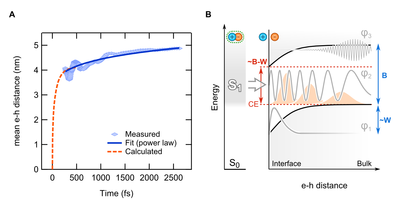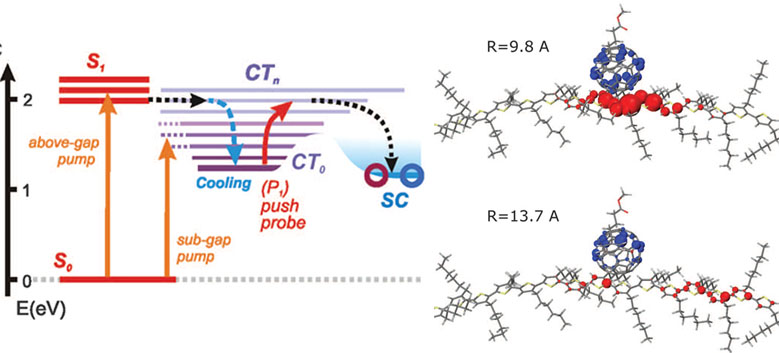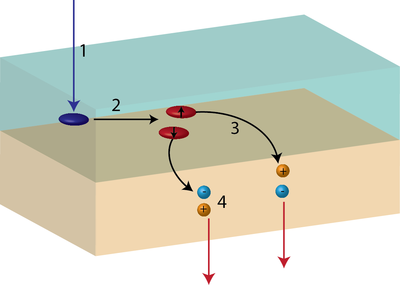The efficient energy and charge transport in organic and hybrid materials is of paramount importance for the development of organic electronic devices. A typical charge/energy transfer event takes a period of time much shorter than a nano- or a pico-second. The rate and efficiency of these processes is highly sensitive to nature of the states, their delocalisation, energy and intermolecular coupling. In our group, we use ultrafast optical, electro- and magneto-optical methods to reveal the mechanistic picture behind the molecular scale energy and charge transfer event in organic electronic materials and devices.
Delocalisation and Coherence effects in Charge Separation in Organic Photovoltaics
We have developed a unique method to measure the strength of electric fields at interfaces with mV accuracy and on fs timescales. Using this method we have shown that efficient charge separation in organic photovoltaics occurs via band-like motion of electrons through delocalised states. This allows charges to escape the Coulomb interaction in 200-300fs and later contribute to the solar cell photocurrent.

Figure 1: (a) The experimentally observed ultrafast motion of electron and hole after the dissociation; (b) The interpretation of experimental results in the frame of ‘coherent charge-separation’ model.
[1]. Gelinas S., et al, Ultrafast long-range charge separation in organic semiconductor photovoltaic diodes, Science, 343, 512 (2014)
Optical control spectroscopy of organic photovoltaic devices
Charge dynamics in organic systems are very sensitive even to minor changes in the molecular geometry and energies of electronic states. Based on this phenomenon, we have recently introduced pump-push photocurrent spectroscopy, which offers a simple and direct route to control the electronic performance of organic electronic devices by switching optically the excited states of the molecules. For example, local electronic states were shown to delocalise upon the population of a coupled vibronic state with a low-energy IR photon. Such delocalization appeared to be one of the key mechanisms for charge generation in organic photovoltaics. We are currently working to realise a more selective optical control through the vibrational states of the molecule.

Figure 2: (a) The diagram of optical control of charge separation in organic photovoltaic devices; (b) The calculated delocalisation of charges by the ‘push’ optical pulse.
[2]. Bakulin A.A., et al., The Role of Driving Energy and Delocalized States for Charge Separation in Organic Semiconductors, Science, 335, 1340 (2012)
Triplet Transfer between Organic and Inorganic Semiconductors
We have recently shown for the first time, that it is possible to efficiently (~100%) transfer spin-triplet excitons from organic to inorganic semiconductors. This discovery paves the way for combining unique properties [link to singlet fission] of easily processible organic semiconductors and widely used solar cells made from inorganic semiconductors such as silicon to further boost their power conversion efficiency beyond the Shockley-Queisser limit. Further, it opens up new possibilities for long-range energy transfer due to the long diffusion length of triplet excitons.

Figure 3: Transfer of spin-triplet excitons (generated via singlet fission) across the organic/inorganic interface
[3]. Tabachnyk M., et al., Resonant energy transfer of triplet excitons from pentacene to PbSe nanocrystals, Nature Materials, 13, 1033 (2014)
